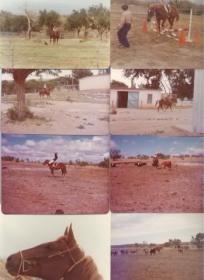[QUOTE=Lady Counselor;7811058]
I start mine bitless, but I do introduce them to a bit so they become acclimated as well. By that, I mean that I use a headstall and a rubber snaffle and teach them to accept it, and wear the headstall while in their stall for a few minutes at a time. This acclimates them to it, showing it’s not a big deal.
My young horses get tons of groundwork. By the time you start on their back, they already have a whoa and can turn easily on command. So I use a rope halter with reins.
Initial sessions for babies are short, ten to fifteen minutes. It’s kindergarten, really. I start them when they show they are mentally ready, so “baby” could be two, three, four years old.
I like to progress to where they are riding easily and have the basics down pat at walk/trot in a halter before adding the bit. Then, I add it for them to carry while still using the halter. After a session or two, switch to the bit and headstall.
That’s how I like to do it. No drama, no trauma, just relaxed and taking them step by step.[/QUOTE]
The question here is, we don’t really know without seeing it directly what exactly the OP is doing.
Depending on that, what anyone may see there and reflect can be almost opposite from what that same observer would say if other was happening.
That above in general is how we started all kinds of horses for many years, ranch and race colts, all the same.
We worked with them on the ground until we felt they were understanding of a human working with them and responded to what we were asking of them.
Some of those took maybe half an hour, others may take some days to get them where we could tie a light long leadrope to the sides of the flat halter, have someone holding it for me and I would, from a bench, slide on and off all over, from both sides.
Once the horse was fine with that, it was led out for a bit and then I would ride it, bareback and in that halter, around the shedrow barn for a few turns.
Generally the next day, after repeating, I would ride it outside around the yard, still bareback and with the halter.
Then we would go to our homemade rope nose hackamore and ride them with that a couple of weeks, eventually adding a plain D snaffle under that, without reins attached yet to it.
By about the third or fourth week, I was riding them either in the rope nose hackamore or snaffle and bringing cattle off the canyons to headquarters on them, like a handful of cows and calves, or bulls, something slow and unexciting.
I really think it is not what you use on their heads as much as how you go about starting the horse.
Many ways can work, as long as they fit the horse you are working with and the human will see when something is not and keep changing until it does.
First picture was the first time on this filly we raised, the spring she was turning two.
One of our stallions gave us many “born broke” foals and she was one of those.
She just came along so very fast, we had handled her all her life and was fine with anything we wanted to do.
That first day, I got on in the barn, then even walked her for some minutes outside around the yard, bareback and with a halter.
A few days later, we had this stump in the yard and decided to drag it out of the way, so she was learning about a rope.
She was really straining to pull it, my fault, I didn’t realize how hard that stump was digging in with those root ends, but she was game and trying hard.
One picture shows how we started adding a snaffle under the rope hackamore for a little bit, then later added the reins and used both reins, then took the hackamore off.
She eventually went to the regional track and did well enough to go to the bigger track.
Not all our colts started quite so fast, most took a little longer, but this filly was born with a great mind, already smart beyond her years:



 )
)
